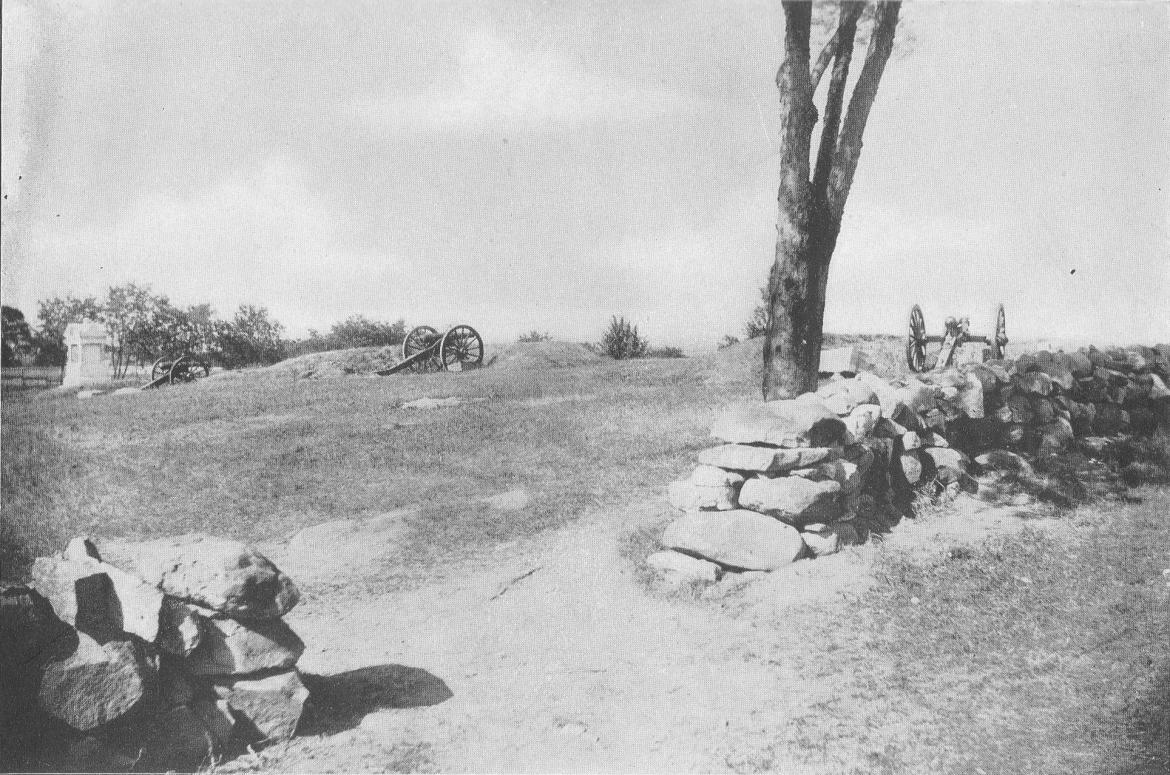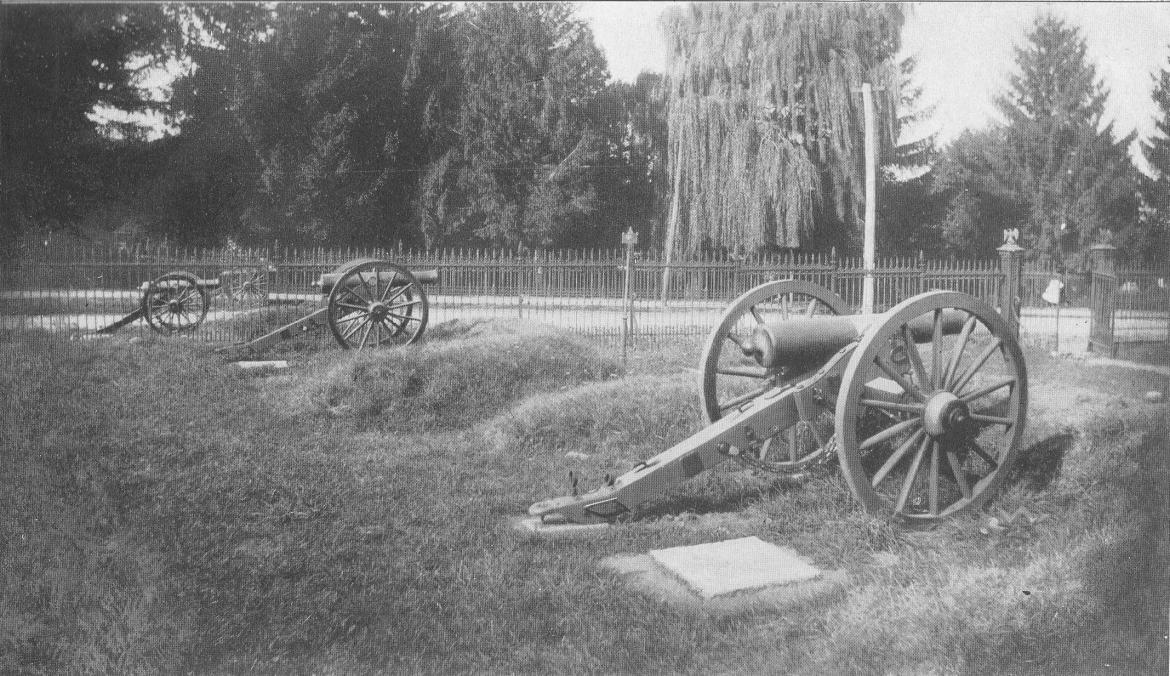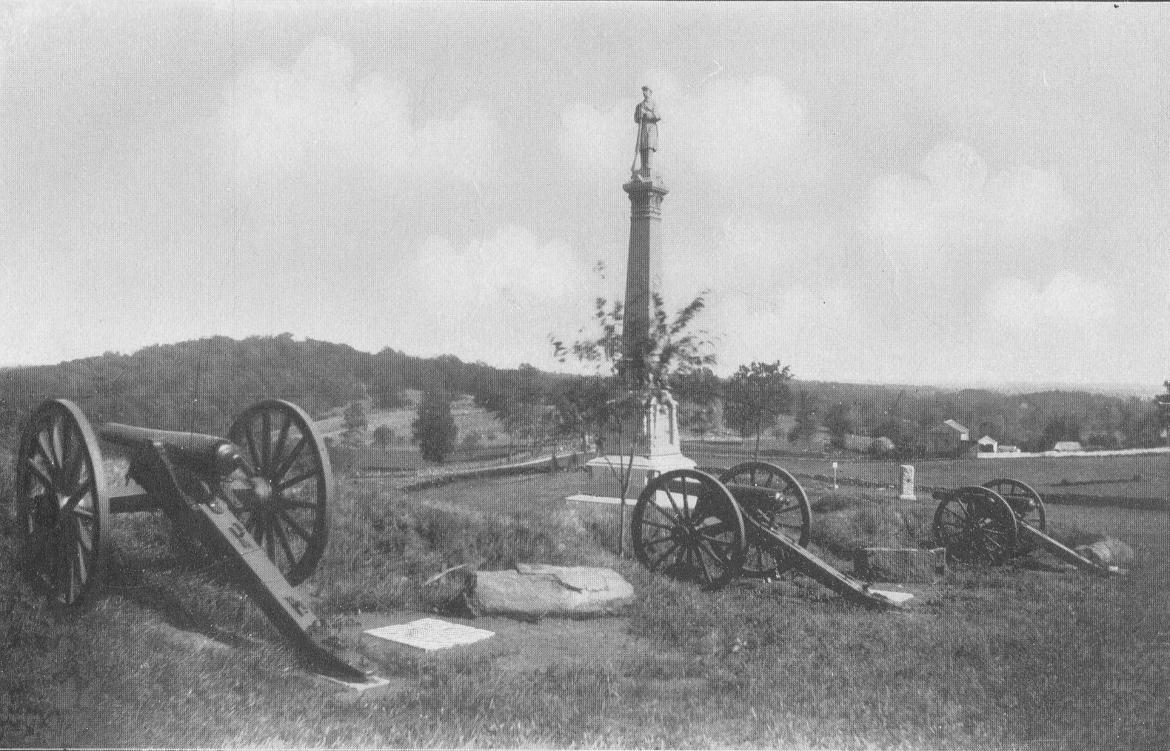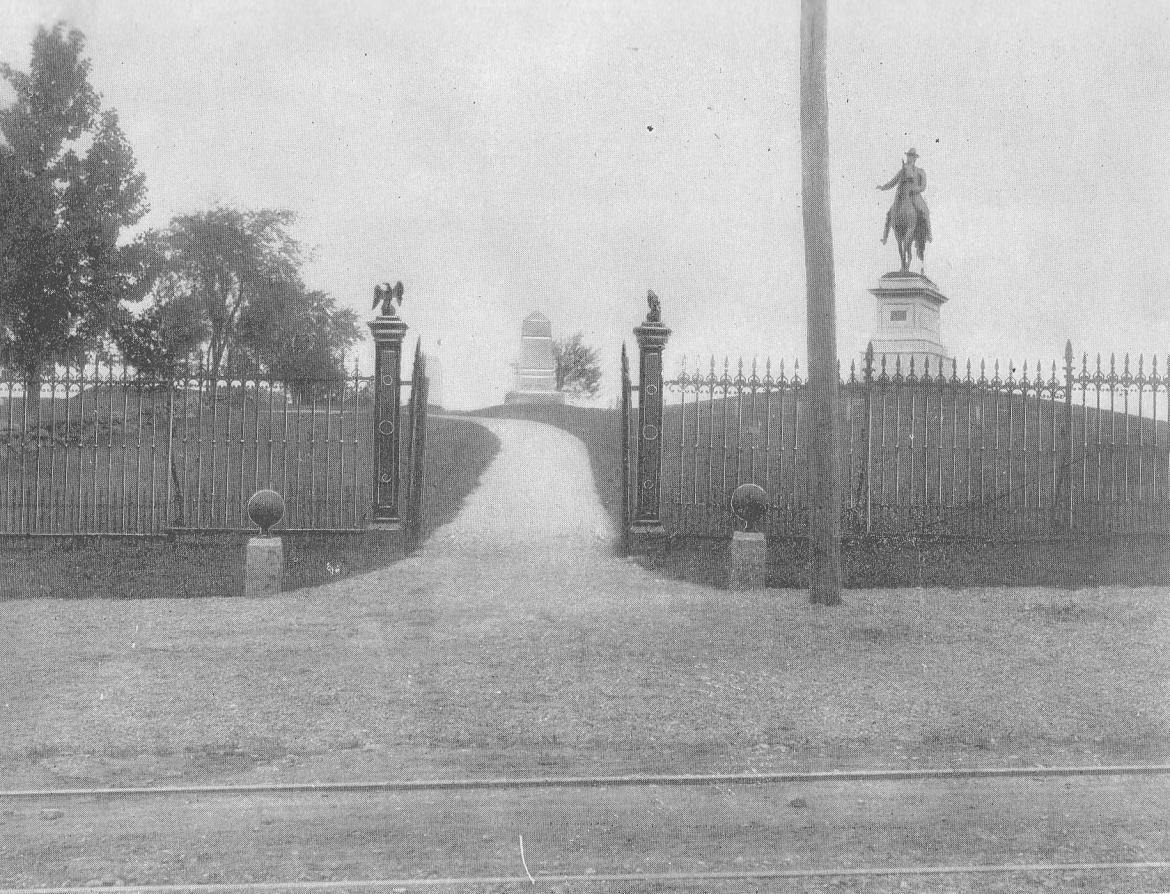This image is titled “A View of Rickett’s Battery F and G, First Pennsylvania Light Artillery, East Cemetery Hill.” The location is East Cemetery Hill east of the Baltimore Pike. Stevens Knoll/McKnight’s Hill is in the left background. The McKnight House is above the left cannon. Part of the monument to Rickett’s Pennsylvania Battery is on the far right. To its left is the small marker to Cooper’s Pennsylvania Battery. To the left of the Cooper’s marker is the monument to the 4th Ohio Infantry Regiment. To the left of the 4th Ohio Monument is the larger monument to Cooper’s Battery. The 1895 commission report states: “The volunteer batteries of the Union Army on the grounds of the Memorial Association are generally represented by one gun and mounted upon inferior carriages. This commission resolved to substitute an improved iron gun carriage. Sixty-two new carriages have been contracted for. Of these about 36 have been furnished by the contractor and placed on the field and mounted with the kind of gun used by each battery, respectively in the battle. The others will be put in position as soon as supplied by the contractor. Excellent granite foundation stones support each carriage. The following have already been placed on the Union lines, viz:…Six carriages and 3-inch rifles (Rickett’s Battery), on East Cemetery Hill. Three carriages and Napoleon guns (Stewart’s Battery), on East Cemetery Hill. Three carriages and 3-inch rifles (right of Rickett’s Battery), on East Cemetery Hill. Three carriages and 3-inch rifles (Wiedrich’s New York Battery), on East Cemetery Hill. All of these guns on East Cemetery Hill occupy redoubts used by said batteries in the battle.” (page 22). This photograph was taken facing south circa 1895. Annual Reports of the Gettysburg National Military Park Commission to the Secretary of War, 1893-1904. Washington. Government Printing Office, 1905.
This image is titled “First New York Battery I, East Cemetery Hill.” The location is East Cemetery Hill east of the Baltimore Pike. On the far left is the monument to Wiedrich’s New York Battery, which was Battery I, First New York Artillery. The 1895 commission report states: “The volunteer batteries of the Union Army on the grounds of the Memorial Association are generally represented by one gun and mounted upon inferior carriages. This commission resolved to substitute an improved iron gun carriage. Sixty-two new carriages have been contracted for. Of these about 36 have been furnished by the contractor and placed on the field and mounted with the kind of gun used by each battery, respectively in the battle. The others will be put in position as soon as supplied by the contractor. Excellent granite foundation stones support each carriage. The following have already been placed on the Union lines, viz:…Six carriages and 3-inch rifles (Rickett’s Battery), on East Cemetery Hill. Three carriages and Napoleon guns (Stewart’s Battery), on East Cemetery Hill. Three carriages and 3-inch rifles (right of Rickett’s Battery), on East Cemetery Hill. Three carriages and 3-inch rifles (Wiedrich’s New York Battery), on East Cemetery Hill. All of these guns on East Cemetery Hill occupy redoubts used by said batteries in the battle.” (page 22). All stone fences and walls which existed at the time of the battle and which are upon ground owned by the United States we have caused to be restored and put in proper condition…” (page 30). This photograph was taken facing northeast circa 1895. Annual Reports of the Gettysburg National Military Park Commission to the Secretary of War, 1893-1904. Washington. Government Printing Office, 1905.
This image is titled “Stewart’s Battery, Fourth United States, East Cemetery Hill.” The location is East Cemetery Hill east of the Baltimore Pike. Although the commission report (see below) states that Stewart’s position was marked by “Three carriages and Napoleon guns…” there are four guns in the picture. Three on this (east) side of the Baltimore Pike and one on the other (west) side of the Baltimore Pike. The fourth gun on the west side of the Baltimore Pike could belong to Hubert Dilger’s Battery I, 1st Ohio Artillery, but the commission report does not state that Dilger’s position had been marked by 1895. In Colonel Charles Wainwright’s (commander of the Artillery of the First Corps) Official Report of the Battle of Gettysburg, he stated the following about Stewart’s position when it reached East Cemetery Hill: “At dusk, no attack having been made, the batteries on the hill outside the cemetery gate were posted as follows, and light earthworks thrown up in front of each gun to protect the men from the fire of the enemy’s sharpshooters: Four guns of Battery B, Fourth U.S. Artillery, across the road so as to command the approaches from the town (two guns of this battery had been disabled by loss of pointing rings) along the north front of the hill;…” (Official Records of the War of the Rebellion Volume 27 Part 1, page 357). The 1895 commission report states: “The volunteer batteries of the Union Army on the grounds of the Memorial Association are generally represented by one gun and mounted upon inferior carriages. This commission resolved to substitute an improved iron gun carriage. Sixty-two new carriages have been contracted for. Of these about 36 have been furnished by the contractor and placed on the field and mounted with the kind of gun used by each battery, respectively in the battle. The others will be put in position as soon as supplied by the contractor. Excellent granite foundation stones support each carriage. The following have already been placed on the Union lines, viz:…Three carriages and Napoleon guns (Stewart’s Battery), on East Cemetery Hill… All of these guns on East Cemetery Hill occupy redoubts used by said batteries in the battle.” (Gettysburg National Military Park Commission Reports page 22). This photograph was taken facing southwest circa 1895. Annual Reports of the Gettysburg National Military Park Commission to the Secretary of War, 1893-1904. Washington. Government Printing Office, 1905.
This image is titled “A View of Cooper’s Battery B, First Pennsylvania Light Artillery, East Cemetery Hill.” The location is East Cemetery Hill east of the Baltimore Pike. Culp’s Hill is in the left background. The McKnight House is in the right background above the right cannon. The monument behind the cannon is to the 4th Ohio Infantry Regiment. To the right of the 4th Ohio monument, and to the left of the far right cannon, is the marker to Battery L, 1st New York Light Artillery, commanded by Gilbert Reynolds and George Breck. The monument was dedicated on September 17, 1889. The 1895 commission report states: “The volunteer batteries of the Union Army on the grounds of the Memorial Association are generally represented by one gun and mounted upon inferior carriages. This commission resolved to substitute an improved iron gun carriage. Sixty-two new carriages have been contracted for. Of these about 36 have been furnished by the contractor and placed on the field and mounted with the kind of gun used by each battery, respectively in the battle. The others will be put in position as soon as supplied by the contractor. Excellent granite foundation stones support each carriage. The following have already been placed on the Union lines, viz:…Six carriages and 3-inch rifles (Rickett’s Battery), on East Cemetery Hill. Three carriages and Napoleon guns (Stewart’s Battery), on East Cemetery Hill. Three carriages and 3-inch rifles (right of Rickett’s Battery)(these are the guns shown in this photograph), on East Cemetery Hill. Three carriages and 3-inch rifles (Wiedrich’s New York Battery), on East Cemetery Hill. All of these guns on East Cemetery Hill occupy redoubts used by said batteries in the battle.” (page 22). This photograph was taken facing southeast circa 1895. Annual Reports of the Gettysburg National Military Park Commission to the Secretary of War, 1893-1904. Washington. Government Printing Office, 1905.
This image is titled “Entrance to East Cemetery Hill, showing General Hancock’s Statue and Walk.” The location is East Cemetery Hill east of the Baltimore Pike. The Hancock Equestrian statue in the right background was dedicated on June 5, 1896 (Gettysburg Star and Sentinel June 9, 1896). The monument to the 14th Indiana Infantry Regiment is in the center background on the east side of the curve in the path. The 14th Indiana Monument was dedicated on October 28, 1885. The monument to Rickett’s Batteries F&G 1st Pennsylvania Light Artillery is just visible to the right of the left gate. The monument to Rickett’s Battery was dedicated on July 4, 1894. The fence along the Baltimore Pike is the Lafayette Square iron fence that had been donated to the Gettysburg Battlefield Memorial Association by a joint resolution of Congress on October 12, 1888 through the efforts of Major General Daniel Edgar Sickles. (Frederick Tilberg, “Historic Cemetery Survey Report” (June 24, 1958), Gettysburg National Military Park vertical files, page 11). Originally enclosing Lafayette Square in Washington, the fence was declared to be no longer needed by District of Columbia authorities, and prompted Sickles to urge the Congressional resolution giving the ornamental fence over to the Gettysburg Preservation and Memorial Association. On July 12, 1889 the Gettysburg Battlefield Memorial Association resolved that “so much of the iron fence, donated by the U. S. Government, be used as is necessary to enclose the front of East Cemetery Hill to Slocum Avenue, and by said avenue to the turn to Culp’s Hill, and that it be erected unpainted, in granite blocks, and according to the lay of the land, the contractor to furnish any castings that are necessary.” (“Minutes of the Gettysburg Battlefield Memorial Association, July 12, 1889,” page 193. The minutes are in the Gettysburg National Military Park Library). This fence was eventually erected sometime after April of 1890 by the firm of Gilbert and Smith. It was envisioned that three gates would be placed along the Baltimore Pike and one along Slocum Avenue where it joined Wainwright Avenue/Brickyard Lane at the base of East Cemetery Hill (Gettysburg Compiler April 8, 1890). Notice the cannon balls mounted on granite blocks in the foreground. The 1897 commission report states: “All these avenues, like those previously built by the commission on the is field, are constructed on the Telford system and are substantial and durable. Wherever along their sides there are sloping banks, these are turfed or set with grass; the guters are well paved with stones, and wherever needful at short curves, low granite pillars, topped with 13-inch shells, have been set on the edge of the avenues to prevent careless driving off the roadway. (page 37). The tracks on the Baltimore Pike are to the Gettysburg Electric Railway or Trolley. This photograph was taken facing northeast circa 1897. Annual Reports of the Gettysburg National Military Park Commission to the Secretary of War, 1893-1904. Washington. Government Printing Office, 1905.
This image is titled “Paving in front of East Cemetery Hill.” The location is East Cemetery Hill east of the Baltimore Pike. The Hancock Equestrian statue in the left background was dedicated on June 5, 1896 (Gettysburg Star and Sentinel June 9, 1896). The monument to the 4th Ohio Infantry Regiment is in the center background to the left of the gate. The 4th Ohio Monument was dedicated on August 23, 1887. The cannon on the other (east) side of the fence and the earthworks represent Lieutenant James Stewart’s Battery B, 4th United States Artillery. The 1895 commission report states: “The volunteer batteries of the Union Army on the grounds of the Memorial Association are generally represented by one gun and mounted upon inferior carriages. This commission resolved to substitute an improved iron gun carriage. Sixty-two new carriages have been contracted for. Of these about 36 have been furnished by the contractor and placed on the field and mounted with the kind of gun used by each battery, respectively in the battle. The others will be put in position as soon as supplied by the contractor. Excellent granite foundation stones support each carriage. The following have already been placed on the Union lines, viz:…Six carriages and 3-inch rifles (Rickett’s Battery), on East Cemetery Hill. Three carriages and Napoleon guns (Stewart’s Battery), on East Cemetery Hill. Three carriages and 3-inch rifles (right of Rickett’s Battery)(these are the guns shown in this photograph), on East Cemetery Hill. Three carriages and 3-inch rifles (Wiedrich’s New York Battery), on East Cemetery Hill. All of these guns on East Cemetery Hill occupy redoubts used by said batteries in the battle.” (page 22). The fence along the Baltimore Pike is the Lafayette Square iron fence that had been donated to the Gettysburg Battlefield Memorial Association by a joint resolution of Congress on October 12, 1888 through the efforts of Major General Daniel Edgar Sickles. (Frederick Tilberg, “Historic Cemetery Survey Report” (June 24, 1958), Gettysburg National Military Park vertical files, page 11). Originally enclosing Lafayette Square in Washington, the fence was declared to be no longer needed by District of Columbia authorities, and prompted Sickles to urge the Congressional resolution giving the ornamental fence over to the Gettysburg Preservation and Memorial Association. On July 12, 1889 the Gettysburg Battlefield Memorial Association resolved that “so much of the iron fence, donated by the U. S. Government, be used as is necessary to enclose the front of East Cemetery Hill to Slocum Avenue, and by said avenue to the turn to Culp’s Hill, and that it be erected unpainted, in granite blocks, and according to the lay of the land, the contractor to furnish any castings that are necessary.” (“Minutes of the Gettysburg Battlefield Memorial Association, July 12, 1889,” page 193. The minutes are in the Gettysburg National Military Park Library). This fence was eventually erected sometime after April of 1890 by the firm of Gilbert and Smith. It was envisioned that three gates would be placed along the Baltimore Pike and one along Slocum Avenue where it joined Wainwright Avenue/Brickyard Lane at the base of East Cemetery Hill (Gettysburg Compiler April 8, 1890). There is a stone wall in the left background on the other (east) side of the iron fence. The 1895 commission report states: “All stone fences and walls which existed at the time of the battle and which are upon ground owned by the United States we have caused to be restored and put in proper condition…” (page 30). Notice the cannon balls mounted on granite blocks in the foreground. The 1897 commission report states: “All these avenues, like those previously built by the commission on this field, are constructed on the Telford system and are substantial and durable. Wherever along their sides there are sloping banks, these are turfed or set with grass; the guters are well paved with stones, and wherever needful at short curves, low granite pillars, topped with 13-inch shells, have been set on the edge of the avenues to prevent careless driving off the roadway. (page 37). The tracks on the Baltimore Pike are to the Gettysburg Electric Railway or Trolley. This photograph was taken facing southeast circa 1897. Annual Reports of the Gettysburg National Military Park Commission to the Secretary of War, 1893-1904. Washington. Government Printing Office, 1905.






